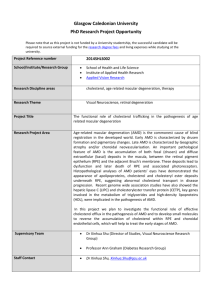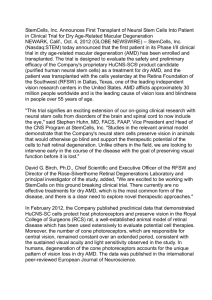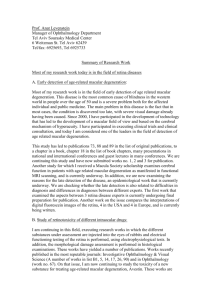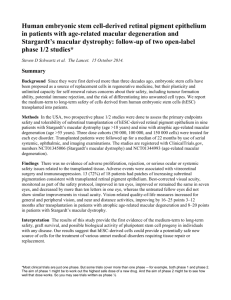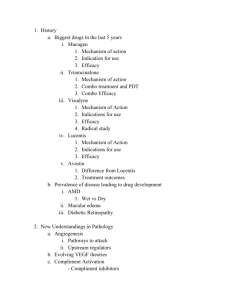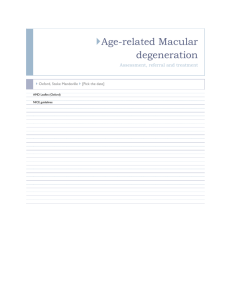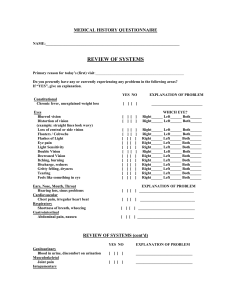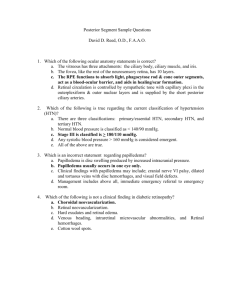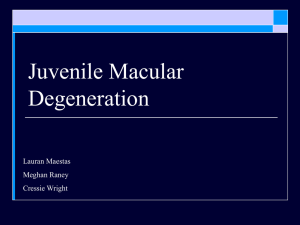protocol
advertisement
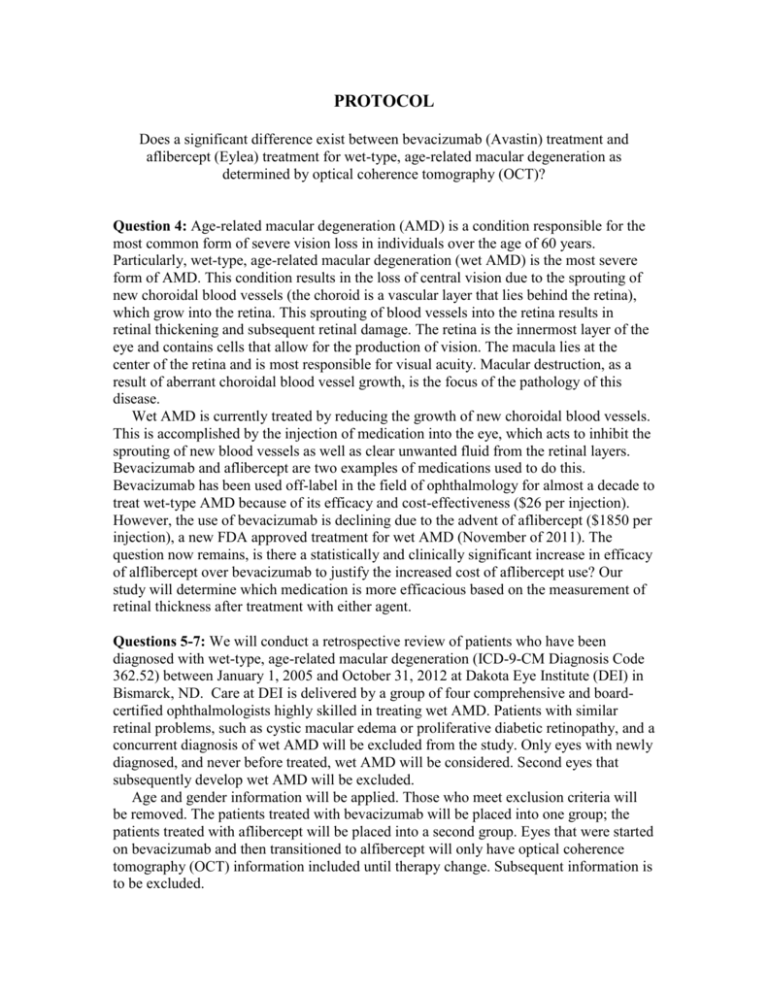
PROTOCOL Does a significant difference exist between bevacizumab (Avastin) treatment and aflibercept (Eylea) treatment for wet-type, age-related macular degeneration as determined by optical coherence tomography (OCT)? Question 4: Age-related macular degeneration (AMD) is a condition responsible for the most common form of severe vision loss in individuals over the age of 60 years. Particularly, wet-type, age-related macular degeneration (wet AMD) is the most severe form of AMD. This condition results in the loss of central vision due to the sprouting of new choroidal blood vessels (the choroid is a vascular layer that lies behind the retina), which grow into the retina. This sprouting of blood vessels into the retina results in retinal thickening and subsequent retinal damage. The retina is the innermost layer of the eye and contains cells that allow for the production of vision. The macula lies at the center of the retina and is most responsible for visual acuity. Macular destruction, as a result of aberrant choroidal blood vessel growth, is the focus of the pathology of this disease. Wet AMD is currently treated by reducing the growth of new choroidal blood vessels. This is accomplished by the injection of medication into the eye, which acts to inhibit the sprouting of new blood vessels as well as clear unwanted fluid from the retinal layers. Bevacizumab and aflibercept are two examples of medications used to do this. Bevacizumab has been used off-label in the field of ophthalmology for almost a decade to treat wet-type AMD because of its efficacy and cost-effectiveness ($26 per injection). However, the use of bevacizumab is declining due to the advent of aflibercept ($1850 per injection), a new FDA approved treatment for wet AMD (November of 2011). The question now remains, is there a statistically and clinically significant increase in efficacy of alflibercept over bevacizumab to justify the increased cost of aflibercept use? Our study will determine which medication is more efficacious based on the measurement of retinal thickness after treatment with either agent. Questions 5-7: We will conduct a retrospective review of patients who have been diagnosed with wet-type, age-related macular degeneration (ICD-9-CM Diagnosis Code 362.52) between January 1, 2005 and October 31, 2012 at Dakota Eye Institute (DEI) in Bismarck, ND. Care at DEI is delivered by a group of four comprehensive and boardcertified ophthalmologists highly skilled in treating wet AMD. Patients with similar retinal problems, such as cystic macular edema or proliferative diabetic retinopathy, and a concurrent diagnosis of wet AMD will be excluded from the study. Only eyes with newly diagnosed, and never before treated, wet AMD will be considered. Second eyes that subsequently develop wet AMD will be excluded. Age and gender information will be applied. Those who meet exclusion criteria will be removed. The patients treated with bevacizumab will be placed into one group; the patients treated with aflibercept will be placed into a second group. Eyes that were started on bevacizumab and then transitioned to alfibercept will only have optical coherence tomography (OCT) information included until therapy change. Subsequent information is to be excluded. The initial (“baseline”) mean central retinal thickness will be obtained before any treatment. The following retinal thicknesses will be determined at each subsequent clinic. With this information and other clinical criteria, the ophthalmologists will determine whether to treat with medical therapy or cautious observation. The study is focused on evaluating the retinal thickness changes based on OCT for each medical treatment irrespective of time, then comparing the changes between each medication. Question 9: The data to be obtained from the medical records of the Dakota Eye Institute is not public data and will be accessed with support and written consent from the practice administrator of the Dakota Eye Institute. See attached letter for letter of support and consent. Data to be recorded will include age, gender, central retinal thickness, and medication used. SPSS 19.0 for Windows will used to analyze demographic and clinical characteristics of patients. Frequencies and relative percentages will be computed for each categorical variable. Chi-square tests or Fisher’s exact tests will be performed to determine which categories were significantly different from one another, and t-test and/or ANOVA will be used to compare continuous variables. All p-values will be two-sided, and p-value < 0.05 will be considered significant. Missing data will be excluded from analysis. Questions 8 & 10: For the purpose of this study, there will be no physical interaction between the principal investigators and the patients whose charts are being reviewed. Furthermore, no procedures will be performed or direct interaction will occur with patients of this study. Data will be stored securely on password protected computers and files. The data file will not contain any identifying information such as patients’ names or medical record numbers. Only those involved in the research project will be able to access the data. Data will be stored in the Department of Family and Community Medicine at the UND School of Medicine and Health Sciences for a period of six years after analysis.


